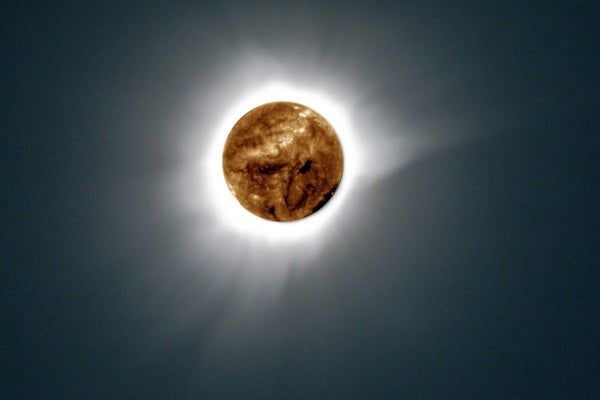Fortunate sighting
I watched totality free from clouds, sailing in a “banana boat” off the coast of the little island of Ternate, Indonesia. My partner and eclipse veteran Deborah Carter was with me, as were two new friends whom we met on the island.
The chase afforded us little time for preparing gear in the narrow and unstable boat. And good thing we didn’t take much time because we cleared the clouds with only seconds remaining before second contact. Adding to the joy of this success was seeing the Moon near perigee, slamming the door on the Sun’s light as the solar corona swelled magnificently into view.
A plucked daisy
To the unaided eye, the equatorial streamers appeared long and dramatic, with one extraordinarily bright streamer extending to the southwest. These streamers formed the brightest part of a largely symmetrical corona. It consisted of numerous overlapping petals, like those of a frosted dahlia in bloom — except for the corona south of the Sun’s polar region, where the petals appeared to have been “plucked.” It was all but a visual black hole with only the faintest of plumes (comet-like plumes) extending tail-like into space.
We appear to be on the downside of a solar maximum, a time when the corona typically bursts forth with streamers radiating from all points of the solar disk. Therefore, the dahlia flower arrangement of coronal petals was expected. Nevertheless, the Sun’s corona is not entirely uniform. Coronal holes, for instance, form predominantly at the Sun’s poles, and the one that appeared at the Sun’s south pole during the eclipse might have been responsible for the corona’s vanishing act.
A different kind
of black hole
The corona is both hot (on the order of 1 million degrees Fahrenheit) and delicate — a million times fainter than the Sun’s photosphere, which is why we see it only during totality. The corona’s intensity is also not uniform, having darker (cooler) areas caused by regions with lower density. On ultraviolet and X-ray images, they appear as “black holes” against the bright corona owing to the lower temperature of the plasma (much as sunspots appear darker against the Sun’s photosphere).
Unlike the equatorial streamers — which form closed magnetic loops and heat up the corona, causing it to glow brightly — coronal holes mark where magnetic field lines expand freely into space without looping back. During eclipses, we can see these open magnetic field lines as polar plumes — the fragile, comet-like polar tails that reached out from the Sun’s south pole during the March 9 eclipse. Indeed, when I compared a SOHO spacecraft ultraviolet image of the Sun taken on the day of totality, I found that a coronal hole was present at Sun’s south pole, which may have contributed to the extreme darkening of the corona at that point.
As usual, send your thoughts and observations to sjomeara31@gmail.com.











